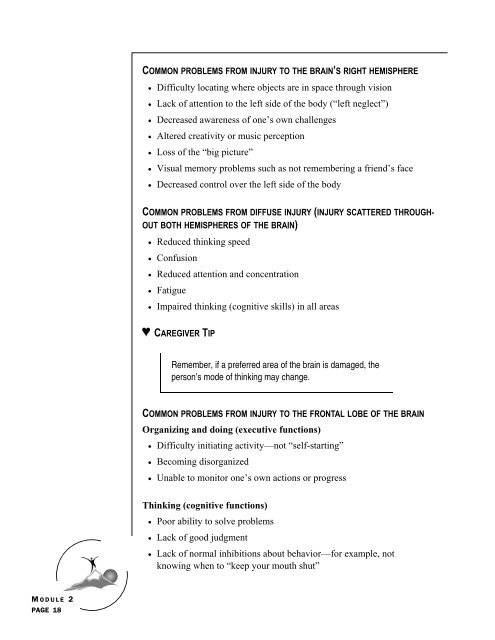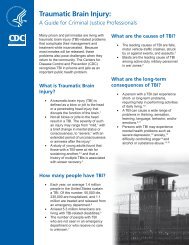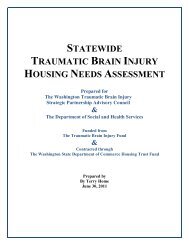caregiver tip - Traumatic Brain Injury Council
caregiver tip - Traumatic Brain Injury Council
caregiver tip - Traumatic Brain Injury Council
You also want an ePaper? Increase the reach of your titles
YUMPU automatically turns print PDFs into web optimized ePapers that Google loves.
COMMON PROBLEMS FROM INJURY TO THE BRAIN’S RIGHT HEMISPHERE<br />
• Difficulty locating where objects are in space through vision<br />
• Lack of attention to the left side of the body (“left neglect”)<br />
• Decreased awareness of one’s own challenges<br />
• Altered creativity or music perception<br />
• Loss of the “big picture”<br />
• Visual memory problems such as not remembering a friend’s face<br />
• Decreased control over the left side of the body<br />
COMMON PROBLEMS FROM DIFFUSE INJURY (INJURY SCATTERED THROUGH-<br />
OUT BOTH HEMISPHERES OF THE BRAIN)<br />
• Reduced thinking speed<br />
• Confusion<br />
• Reduced attention and concentration<br />
• Fatigue<br />
• Impaired thinking (cognitive skills) in all areas<br />
♥ CAREGIVER TIP<br />
Remember, if a preferred area of the brain is damaged, the<br />
person’s mode of thinking may change.<br />
COMMON PROBLEMS FROM INJURY TO THE FRONTAL LOBE OF THE BRAIN<br />
Organizing and doing (executive functions)<br />
• Difficulty initiating activity—not “self-starting”<br />
• Becoming disorganized<br />
• Unable to monitor one’s own actions or progress<br />
Thinking (cognitive functions)<br />
• Poor ability to solve problems<br />
• Lack of good judgment<br />
• Lack of normal inhibitions about behavior—for example, not<br />
knowing when to “keep your mouth shut”<br />
M ODULE 2<br />
PAGE 18






